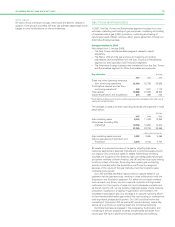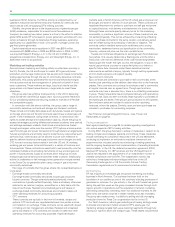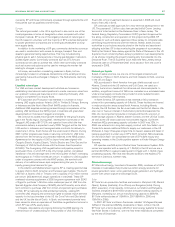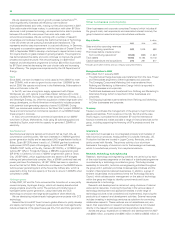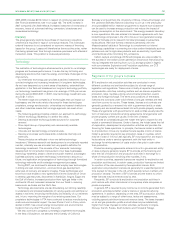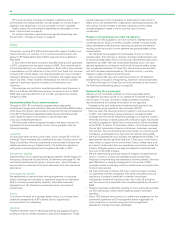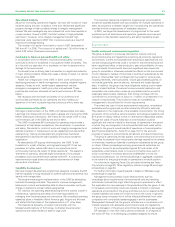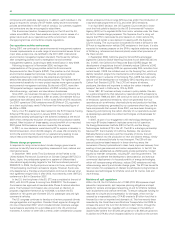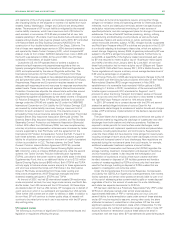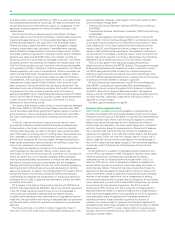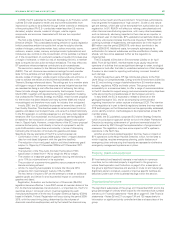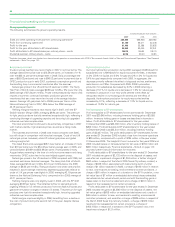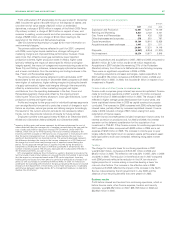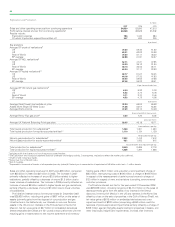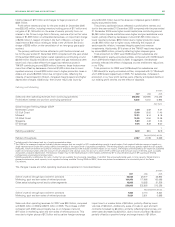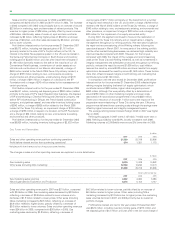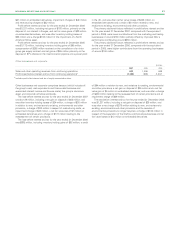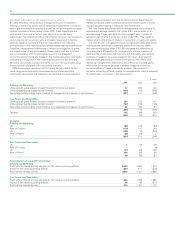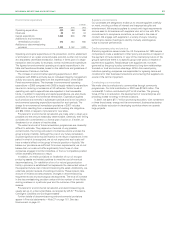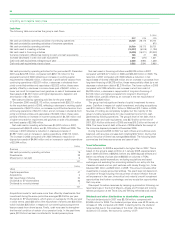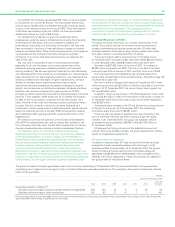BP 2007 Annual Report Download - page 47
Download and view the complete annual report
Please find page 47 of the 2007 BP annual report below. You can navigate through the pages in the report by either clicking on the pages listed below, or by using the keyword search tool below to find specific information within the annual report.
BP ANNUAL REPORT AND ACCOUNTS 2007 45
In 2005, the EC published its Thematic Strategy on Air Pollution, which
outlines EU-wide targets for health and environmental benefits from
improved air quality to be achieved through further controls on emissions
of fine particulates (PM 2.5 – particulate matter less than 2.5 microns
diameter), sulphur dioxide, oxides of nitrogen, volatile organic
compounds and ammonia. Associated with this are two important
directives.
The first is the Ambient Air Quality and Cleaner Air for Europe
Directive (AAQD). This consolidates existing ambient air quality legislation
(which prescribes ambient air quality limit values for sulphur dioxide,
oxides of nitrogen, particulate matter, lead, carbon monoxide, ozone,
cadmium, arsenic, nickel, mercury and polyaromatic hydrocarbons) and
introduces new controls on the concentration of fine particles in ambient
air. If the concentration of a pollutant exceeds air quality limit values plus
a margin of tolerance, or there is a risk of exceeding the limit, a member
state is required to take action to reduce emissions. This may affect any
BP operations whose emissions contribute to such exceedances.
The second is a revision to the National Emissions Ceiling Directive
(NECD). This will introduce new emissions ceilings for each member
state for fine particles and will tighten existing ceilings for sulphur
dioxide, oxides of nitrogen, volatile organic compounds and ammonia, in
order to achieve the health and environmental benefits set in the
Thematic Strategy referenced above. The ceilings set for a member state
will trigger a range of abatement measures across industrial sectors that
are assessed as being a cost effective means of achieving the ceiling.
Recent climate change targets announced by the European Council in
March 2007, together with developments in the atmospheric modeling
that underpins the Thematic Strategy and NECD, mean that the proposal
for the revision has been delayed until early summer 2008 and may be
more stringent and therefore more costly for industry than anticipated.
In early 2007, the EC published its proposal to amend the current EU
Fuel Quality Directive. This directive seeks to set environment limits on
gasoline and diesel road transport fuels, and as such is linked historically
to the EU legislation on vehicle (passenger car and heavy duty) regulated
emissions (the ‘Euro standards’) and has previously set the legislative
timetable for the introduction of ultra-low sulphur (50ppm) and sulphur-
free (510ppm) fuels. However, a major theme of the EC’s new proposal
concerns biofuel policy, both directly in terms of a proposal to set life
cycle GHG emission reductions and indirectly in terms of attempting
facilitating the introduction of biofuels into gasoline and diesel.
Specifically the key elements of the EC’s current proposal are:
– Confirmation of the 1 January 2009 sulphur-free (510ppm) deadline
date for road diesel (alignment with the gasoline deadline).
– The reduction of non-road gasoil sulphur and inland waterway gasoil
sulphur to 10ppm by 31 December 2009 and 31 December 2011
respectively.
– The reduction of the Poly-cyclic Aromatic Hydrocarbon (PAH)
specification in diesel from 11% by weight to 8% by weight.
– The creation of a separate grade of gasoline allowing the blending to
up to 10% by volume ethanol or its equivalent.
– The provision of a summer-time gasoline vapour pressure waiver for
blends containing ethanol.
– Article 7a, requiring fuel suppliers to reduce the life-cycle GHG
emissions from road transport fuels by 10% by 2020.
The key items of impact to BP are the attempt to create an additional
gasoline grade, and Article 7a and its potential impact on conventional
gasoline and diesel.
Registration, Evaluation and Authorization of Chemicals (REACH)
legislation became effective 1 June 2007 across all member states of the
EU. All chemical substances manufactured in, or imported into, the EU in
quantities above 1 tonne per annum must be registered by each
manufacturer/importer with the new European Chemical Agency (ECHA)
based in Helsinki, Finland. Registration will occur during the period 2008-
2018, with the exact timing being determined by the volumes of
chemicals manufactured/imported, and by the hazard the chemical may
pose to human health and the environment. Time limited authorizations
may be granted for substances of ‘high concern’. Crude oil and natural
gas are exempt, while fuels will be exempted from authorization but not
registration. In BP, REACH will affect our refining, petrochemicals and
other chemical manufacturing operations, with many other businesses,
such as lubricants, also being impacted in their roles as an importer or
downstream user of chemicals. BP’s updated broad estimate (there are
still many unknowns) indicates that the cost impacts of REACH for BP,
covering hundreds of registrations, are expected to be in the region of
$60 million over the period 2008-2018, with about two-thirds in the
period 2008-2010. Additional costs, for example submissions for
authorization for relevant substances and the modification of safety data
sheets, will have to be assessed further as the regulation is
implemented.
The EC adopted a Directive on Environmental Liability on 21 April
2004. From 30 April 2007, member states must usually require the
operators of activities that cause significant damage to water, ecological
resources or land after that date to undertake restoration of that damage.
Provision is also made for reporting and tackling imminent threats of
such damage.
During the past two years, BP has contributed actively to the High
Level Group on Competitiveness, Energy and the Environment chaired by
the EC and involving a range of stakeholders from EU member states,
industry, regulators, NGOs and trade unions. This group worked
successfully on a consensus basis, to offer a range of recommendations
to the EC intended to support energy and environmental policy objectives
while advancing the competitiveness of the European economy.
In early 2008, the EC is expected to release a directive on the
geological storage of CO
2
and an accompanying communication
regarding incentives for carbon capture and storage (CCS). The intention
of the regulation is in part to identify regulatory barriers that may restrict
CCS technologies, so that those barriers can be appropriately addressed,
and to identify common methodologies to be implemented across EU
member states.
In 2005, the EC published a proposed EC Marine Strategy Directive,
which would adopt an approach similar to that in the Water Framework
Directive by requiring achievement of ‘good environmental status’ for
marine waters by 2021 through the implementation of programmes of
measures. The legislation may have some impact on BP’s upstream
operations in the North Sea.
Another environment-related regulation that may have an impact on
BP’s operations is the Major Hazards Directive, which, for the sites to
which it applies, requires emergency planning, public disclosure of
emergency plans and ensuring that hazards are assessed and effective
emergency management systems are in place.
Property, plants and equipment
BP has freehold and leasehold interests in real estate in numerous
countries, but no individual property is significant to the group as a
whole.SeeExplorationandProductiononpage14foradescriptionof
the group’s significant reserves and sources of crude oil and natural gas.
Significant plans to construct, expand or improve specific facilities are
described under each of the business headings within this section.
Organizational structure
The significant subsidiaries of the group at 31 December 2007 and to the
group percentage of ordinary share capital (to the nearest whole number)
are set out in Financial statements – Note 46 on page 167. See Financial
statements – Notes 26 and 27 on pages 134 and 135 respectively for
information on significant jointly controlled entities and associates of the
group.


